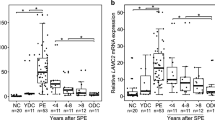Abstract
Background
Determining the benign or malignant nature of biliary strictures can be challenging. Vascular endothelial growth factor (VEGF) plays an important role in tumor angiogenesis.
Objective
The purpose of this study was to investigate whether VEGF levels in bile aspirated during endoscopic retrograde cholangiography (ERCP) can distinguish pancreatic cancer from other causes of biliary stricture.
Methods
Bile was directly aspirated in 53 consecutive patients from March 2012 to October 2012 during ERCP from the common bile duct including 15 with pancreatic cancer, 18 with primary sclerosing cholangitis (PSC), nine with cholangiocarcinoma (CCA), and 11 with benign biliary conditions (sphincter of Oddi and choledocholihiasis). Levels of VEGF in bile were measured. The diagnostic performance was then validated in a second, independent validation cohort of 18 patients (pancreatic cancer n = 10, benign n = 8).
Results
A total of 53 consecutive patients were recruited. The median bile VEGF levels were significantly elevated in patients with pancreatic cancer (1.9 ng/ml (interquartile range [IQR] 0.7, 2.2) compared to those with benign biliary conditions (0.3 ng/ml [IQR 0.2, 0.6]; p < 0.001), PSC (0.7 ng/ml [IQR 0.5, 0.9]; p = 0.02) or CCA (0.4 ng/ml [IQR 0.1, 0.5]; p < 0.001). A VEGF cut-off value of 0.5 ng/ml distinguished pancreatic cancer from CCA with a sensitivity and specificity of 93.3 and 88.9 %, respectively, and area under curve (AUC) of 0.93, and from benign conditions with a sensitivity and specificity of 93.3 and 72.7 %, respectively, with AUC of 0.89. The diagnostic accuracy of biliary VEGF was confirmed in the second independent validation cohort.
Conclusions
This study suggests that measurement of biliary VEGF-1 levels distinguishes patients with pancreatic cancer from other etiologies of biliary stricture. This may be particularly relevant in approaching patients with indeterminate biliary stricture.




Similar content being viewed by others
Abbreviations
- AUC:
-
Area under curve
- CCA:
-
Cholangiocarcinoma
- ERCP:
-
Endoscopic retrograde cholangiopancreatography
- PSC:
-
Primary sclerosing cholangitis
- VEGF:
-
Vascular endothelial growth factor
References
Parsi MA. Peroral cholangioscopy in the new millennium. World J Gastroenterol. 2011;17:1–6.
Parsi MA, Deepinder F, Lopez R, Stevens T, Dodig M, Zuccaro G. Factors affecting the yield of brush cytology for the diagnosis of pancreatic and biliary cancers. Pancreas. 2011;40:52–54.
Ponchon T, Gagnon P, Berger F, et al. Value of endobiliary brush cytology and biopsies for the diagnosis of malignant bile duct stenosis: results of a prospective study. Gastrointest Endosc. 1995;42:565–572.
Baron TH, Harewood GC, Rumalla A, et al. A prospective comparison of digital image analysis and routine cytology for the identification of malignancy in biliary tract strictures. Clin Gastroenterol Hepatol. 2004;2:214–219.
Lee JG, Leung JW, Baillie J, et al. Benign, dysplastic, or malignant making sense of endoscopic bile duct brush cytology: results in 149 consecutive patients. Am J Gastroenterol. 1995;90:722–726.
Kocjan G, Smith AN. Bile duct brushings cytology: potential pitfalls in diagnosis. Diagn Cytopathol. 1997;16:358–363.
Parsi MA, Li A, Li CP, et al. DNA methylation alterations in endoscopic retrograde cholangiopancreatography brush samples of patients with suspected pancreaticobiliary disease. Clin Gastroenterol Hepatol. 2008;6:1270–1278.
Ikeda N, Adachi M, Taki T, et al. Prognostic significance of angiogenesis in human pancreatic cancer. Br J Cancer. 1999;79:1553–1563.
Niedergethmann M, Hildenbrand R, Wostbrock B, et al. High expression of vascular endothelial growth factor predicts early recurrence and poor prognosis after curative resection for ductal adenocarcinoma of the pancreas. Pancreas. 2002;25:122–129.
Alvaro D, Barbaro B, Franchitto A, et al. Estrogens and insulin-like growth factor 1 modulate neoplastic cell growth in human cholangiocarcinoma. Am J Pathol. 2006;169:877–888.
Park BK, Paik YH, Park JY, et al. The clinicopathologic significance of the expression of vascular endothelial growth factor-C in intrahepatic cholangiocarcinoma. Am J Clin Oncol. 2006;29:138–142.
Alvaro D, Macarri G, Mancino MG, et al. Serum and biliary insulin-like growth factor I and vascular endothelial growth factor in determining the cause of obstructive cholestasis. Ann Intern Med. 2007;147:451–459.
Brown LF, Berse B, Jackman RW, et al. Expression of vascular permeability factor (vascular endothelial growth factor) and its receptors in adenocarcinomas of the gastrointestinal tract. Cancer Res. 1993;53:4727–4735.
Ai KX, Lu LY, Huang XY, Chen W, Zhang HZ. Prognostic significance of S100A4 and vascular endothelial growth factor expression in pancreatic cancer. World J Gastroenterol. 2008;14:1931–1935.
Acknowledgments
We would like to thank Jeffrey Hammel for help with statistical analysis. The study is supported by a research grant from the Inflammatory Bowel Disease Working Group and American College of Gastroenterology grant (both to U.N) and in part by the National Institutes of Health, National Center for Research Resources, CTSA UL1TR 000439-06 Cleveland, Ohio.
Conflict of interest
The authors declared no financial conflict of interest pertaining to this paper. Dr. John Vargo is a consultant for Olympus America, Boston Scientific, Cook Medical, and Ethicon EndoSurgery.
Author information
Authors and Affiliations
Corresponding author
Electronic supplementary material
Below is the link to the electronic supplementary material.
Rights and permissions
About this article
Cite this article
Navaneethan, U., Gutierrez, N.G., Jegadeesan, R. et al. Vascular Endothelial Growth Factor Levels in Bile Distinguishes Pancreatic Cancer from Other Etiologies of Biliary Stricture: A Pilot Study. Dig Dis Sci 58, 2986–2992 (2013). https://doi.org/10.1007/s10620-013-2764-0
Received:
Accepted:
Published:
Issue Date:
DOI: https://doi.org/10.1007/s10620-013-2764-0




